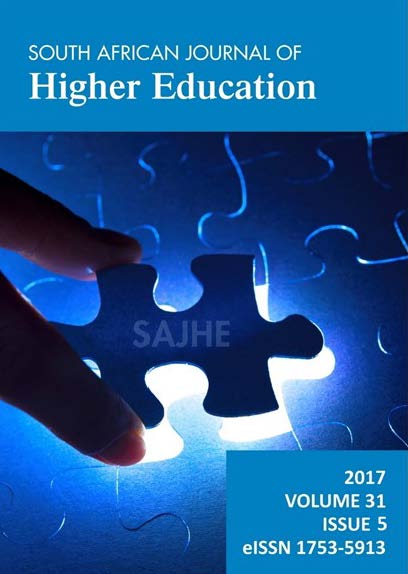Writing into design: An embedded writing course for architectural studies
DOI:
https://doi.org/10.20853/31-5-1497Abstract
Architects must be able to express their ideas clearly to communicate their designs; at the same time graduate professional degree programs demand advanced critical literacy and academic writing skills. Competence in this domain for high school graduates in South Africa often falls short of the expected proficiencies of first-year students at tertiary level. To address this gap, an embedded writing course was integrated into the first-year Design Studio and History of Architecture course. This intervention adopted the approaches provided by writing-intensive pedagogy, successfully improving students’ written expression, and their ability to engage with their architectural studies in deeper and more critical ways.
Downloads
References
R.L. Hoag and D.W. Smit, “Writing in Design Studio,” in We Are a Discipline (25th National Conference on the Beginning Design Student, Louisiana State University, Baton Rouge, LA, 2009), http://novicedesign.org/NCBDS/25/pdf/HoagR_Writing_in_Design.pdf. (accessed 21 September 2014), 93.
Ariane Janse van Rensburg, “Questionnaire on ARPL1000, Distributed to Students Who Had Completed the Course between 2007 and 2011” on-line questionnaire, (Unpublished Material, August 2012).
Mark R.O. Olweny, “Socialisation in Architecture Education,” AAE, 2013, http://architecturaleducators.wordpress.com/http://architecturaleducators.files.wordpress.com/2013/12/olweny-2013-socialisation-in-architectural-education.pdfconference-2013/conference-2013-papers/ (accessed 24 September 2014).
B.S. Bloom et al., Taxonomy of Educational Objectives: The Classification of Educational Goals. Handbook I: Cognitive Domain. (New York: David McKay Company, 1956).
Council on Higher Education, “Access and Throughput in South African Higher Education - Three Case Studies,” in Higher Education Monitor 9 (Pretoria: Council on Higher Education, 2010), http://www.che.ac.za/media_and_publications/higher-education-monitor/higher-education-monitor-9-access-and-throughput (accessed 23 August 2011), 75.
Elizabeth A. City et al., Instructional Rounds in Education: A Network Approach to Improving Teaching and Learning, Book, Whole (Cambridge, Mass.: Harvard Education Press, 2009).
Pierre Bourdieu, Outline of a Theory of Practice, Book, Whole (Cambridge: Cambridge University Press, 1977).
Pierre Bourdieu and Jean Claude Passeron, Reproduction in Education, Society and Culture, vol. 2, Theory, Culture & Society., Book, Whole (London: Sage, 1990).
Sue Clegg, “Cultural Capital and Agency: Connecting Critique and Curriculum in Higher Education,” British Journal of Sociology of Education 32, no. 1 (2011): 93–108.
Hilary Janks, Literacy and Power, Language, Culture and Teaching (New York, London: Routledge, 2010).
Ariane Janse van Rensburg “Enabling Transformation – A Model for Facilitating Successful Design Learning Outcomes in First Year Bachelor of Architectural Studies” PhD Thesis, (Johannesburg: University of the Witwatersrand, 2015).
Paolo Freire, The Pedagogy of the Oppressed (London: Penguin Books Ltd., 1990).
Council on Higher Education, “Access and Throughput in South African Higher Education - Three Case Studies.”
Nora Wendl, “Scratching the Tabula Rasa: Writing Towards Building,” in Proceedings: 25th National Conference on the Beginning Design Student We Are a Discipline (25th National Conference on the Beginning Design Student, Louisiana State University, Baton Rouge, LA, 2009), http://novicedesign.org/NCBDS/25/pdf/WendiN_Scratching_the_Tabula.pdf (accessed 10 October 2014), 263.
Donald A. Schön, The Reflective Practitioner: How Professionals Think in Action, Book, Whole (New York: Basic, 1983), 80.
Janet Emig, “Writing as a Mode of Learning,” College Composition and Communication 28, no. 2 (1977): 122–28.
R Menary, “Writing as Thinking,” Language Sciences 29 (2007): 622.
Timothy Love, “A Minor Theory of Architecture - An Argument for Focusing (Again) on the Specific Architectural Operation,” in Proceedings: 22nd National Conference on the Beginning Design Student - Intersections (22nd National Conference on the Beginning Design Student, Iowa, 2006), http://novicedesign.org/NCBDS/22/22.html (accessed 6 October 2014), 194.
Janssen Callender and Stacey Callender, “Constructing Passages: Accommodations for Diverse Learners in Architectural Education,” in Proceedings: 21st National Conference on the Beginning Design Student San Antonio 2005 - A Beginner’s Mind (21st National Conference on the Beginning Design Student, University of Texas, San Antonio, 2005), http://novicedesign.org/NCBDS/21/pdf/08_ConstructingPassages.pdf (accessed 22 September 2014).
Pauline Gibbons, Scaffolding Language, Scaffolding Learning: Teaching Second Language Learners in the Mainstream Classroom, Book, Whole (Portsmouth, NH: Heinemann, 2002).
J.C. Bean, Engaging Ideas (San Francisco: Jossey-Bass, 2011), 120.
Phaswane Mpe, Welcome to Our Hillbrow (Pietermaritzburg: University of Natal Press, 2001).
Michel de Certeau, The Practice of Everyday Life. (Berkley: University of California Press, 1984).
Walter Benjamin, The Arcades Project (Cambridge, MA: The Belknap Press, 1999).
Mongane Wally Serote, “City Johannesburg,” in The Paperbook of South African Poetry (Johannesburg: AD Donker, 1986), 166–67.
William Plomer, “Johannesburg,” in The Paperbook of South African Poetry (Johannesburg: AD Donker, 1986), 88–89.
Lionel Abrahams, “The Fall of van Eck House,” in Journal of a New Man (Johannesburg: AD Donker, 1984).
Lionel Abrahams, “Thoughts on Johannesburg’s Centenary (While by the Jukskei River at Broederstroom),” in From Jo’burg to Jozi (Johannesburg: Penguin, 2010), 13–15.
Ivan Vladislavic, “Street Addresses,” in blank_Architecture, Apartheid and After (Rotterdam: NAI Publishers, 1998), 305–13.
Neill Blomkamp, District 9 (USA: Tristar Pictures and Wingnut Films et al, 2009).
Downloads
Published
How to Cite
Issue
Section
License
This journal is an open access journal, and the authors and journal should be properly acknowledged, when works are cited.
Authors, copyright holders, may use the publishers version for teaching purposes, in books, theses, dissertations, conferences and conference papers.
A copy of the authors' publishers version may also be hosted on the following websites:
- Non-commercial personal homepage or blog.
- Institutional webpage.
- Authors Institutional Repository.
The following notice should accompany such a posting on the website: This is an electronic version of an article published in SAJHE, Volume XXX, number XXX, pages XXX “XXX", DOI. Authors should also supply a hyperlink to the original paper or indicate where the original paper (http://www.journals.ac.za/index.php/SAJHE) may be found.
Authors publishers version, affiliated with the Stellenbosch University will be automatically deposited in the University Institutional Repository SUNScholar.
Articles as a whole, may not be re-published with another journal.
The following license applies:
Attribution CC BY-NC-ND 4.0





